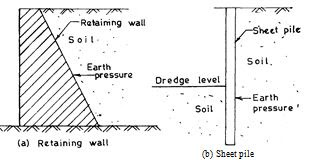SOIL MECHANICS & FOUNDATION ENGINEERING BOOK DOWNLOAD K.R ARORA
SOIL MECHANICS & FOUNDATION ENGINEERING BOOK DOWNLOAD K.R ARORA
KINDLY SCROLL DOWN AND DOWNLOAD
short description about the book
The word `soil' is derived from the Latin word sodium which, according to Webster's dictionary, means the upper layer of the earth that may be dug or ploughed; specifically, the loose surface material of the earth in which plants grow.
The above definition of soil is used in the field of agronomy where the main concern is in the use of soil for raising crops. In geology, the earth's crust is assumed to consist of unconsolidated sediments, called mantle or regolith, overlying rocks. The term `soil' is used for the upper layer of the mantle which can support plants.
The material which is called soil by the agronomist or the geologist is known as topsoil in geotechnical engineering or soil engineering. The topsoil contains a large quantity of organic matter and is not suitable as a construction material or as a foundation for structures. The topsoil is removed from the earth's surface before the construction of structures. For more visit here
The term `soil' in. soil engineering is defined as an unconsolidated material, composed of solid particles, produced by the disintegration of rocks. The void space between the particles may contain air, water or both. The solid particles may contain organic matter.
The soil particles can be separated by such mechanical means as agitation in water. A natural aggregate of mineral particles bonded by strong and permanent cohesive forces is called `rock'. It is an indurated material that requires drilling, wedging or blasting for its removal from the earth's surface. Since the terms weak and strong have different interpretations, the boundary between soil and rock is rather arbitrary.
In the case of partially disintegrated rock, it is extremely difficult to locate the boundary between soil and rock. Fig. 1.1 shows a cross-section through the earth's surface, indicating the nomenclature used in geology
DEFINITION OF SOIL MECHANICS
The term `soil mechanics' was coined by Dr. Karl Terzaghi in 1925 when his book Erdbaumechmiie t the subject was published in German. According to Terzaghi,
`Soil mechanics is the application of the, 'a of mechanics and hydraulics to engineering problems dealing with sediments and other unions accumulations of solid particles produced by the mechanical and chemical disintegration of rock.
regard of whether or not they contain an admixture of organic constituents'. Soil mechanics is, therefore, a tzar of mechanics which deals with the action of forces on soil and with the flow of water in the soil. The soil consists of discrete solid particles which are neither strongly bonded as solids nor they are as fi as particles of fluids. Consequently, t
The behaviour of soil is somewhat intermediate between that of a road a fluid. It is not, therefore, surprising that soil mechanics draw heavily from solid mechanics an.'. Al mechanics. As the soil is inherently a particulate system. soil mechanics is also called particulate mechanics Rock mechanics is the science dealing with the mechanics of rocks.
DEFINITION OF SOIL ENGINEERING AND GEOTECHNICAL ENGINEERING
- Soil engineering in an applied science dealing with the applications of principles of soil mechanics to practical problems.
- It has a much wider scope than soil mechanics, as it deals with all engineering problems related to soils.
- It includes site investigations, design and construction of foundations, earth-retaining structures and earth structures.
- Geotechnical engineering is a broader term that includes soil engineering, rock mechanics and geology
CIVIL NOTES -CLICK HERE













COMMENTS